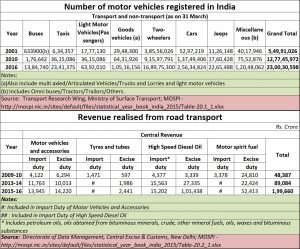https://www.freepressjournal.in/cmcm/economic-policy-little-vision-less-consultation
Auto sector revival key to economic revival
RN Bhaskar – August 22, 2019
Budget reviews are normally written within a fortnight after the papers are tabled in Parliament. This belated review comes in the wake of sharply declining sales, slashing of temporary employees in the automobile sector and a worsening gloom in the economy as a result of the sharp slowdown.
 What is sad is that the government knew of an impending economic slowdown more than a year ago. This columnist wrote about it (http://www.asiaconverge.com/2017/02/tough-times-ahead-for-indian-economy/). The auto sector is a key player in the economy. Hence, this article is about the automobile sector. This is also because the sharpest pangs of pain are being felt by those associated with this sector. So far it has done quite well for itself (see table). But now it needs help. This article is an attempt to suggests a way out of this imbroglio.
What is sad is that the government knew of an impending economic slowdown more than a year ago. This columnist wrote about it (http://www.asiaconverge.com/2017/02/tough-times-ahead-for-indian-economy/). The auto sector is a key player in the economy. Hence, this article is about the automobile sector. This is also because the sharpest pangs of pain are being felt by those associated with this sector. So far it has done quite well for itself (see table). But now it needs help. This article is an attempt to suggests a way out of this imbroglio.
The government has announced an automobile policy that could be seriously flawed. More gratingly, it chose to announce it at the wrong time.
After all, everyone knew about the slowdown in the automobile sector. It was in evidence almost four quarters ago. The slowdown accelerated after the budget announcements.
When there is a slowdown, the government should not discourage customers from making purchases. But willy-nilly the government decided to announce a deadline for conventional vehicles. It also announced tax sops for electric vehicles (EVs). As a result, more than half the customers who would have purchased cars, decided to postpone the buy. That worsened the pain.
So what is to be done? Obviously, customers must be brought back, quickly. At stake is not just the auto industry, but government revenues as well (see chart). Remember, the auto sector is crucial for the steel and power sectors too. It is a large employer – employing around 37 million people directly or indirectly. Since each employee could be expected to support a family of four people, this would affect some 15% of the entire population. So, how does one woo customers back. The indirect taxes from the salaries and output of all these sectors could be several times bigger.
One solution is to dust off the folder containing the cash-to-clunkers proposal the industry made to the government in the first quarter of 2016 (http://www.asiaconverge.com/2016/04/new-vehicles-for-old/). This proposal requested the government to allow customers a 25% rebate on taxes and duties on new vehicles if they deposited their old vehicles at designated places in exchange for new ones. That would result in old vehicles coming to a designated place; it would increase sale of new vehicles; it would allow steel mills to get scrap in abundance instead of importing it.
It would make the automobile industry hum once again.
But preceding that, the government must withdraw the EV policy – both the duty cuts, and the deadline for conventional cars. In any case, conventional vehicles have an expiry date penciled in. Let industry discover it. The government should not dictate the date for two reasons:
The first is that a disruption in auto and power sectors is unavoidable (do view Tony Seba’s lecture at https://www.youtube.com/watch?v=2b3ttqYDwF0).
Second, the existing automobile is highly inefficient (http://www.natcap.org/sitepages/pid56.php). As experts have pointed out “of the energy in the fuel it consumes, at least 80 percent is lost, mainly in the engine’s heat and exhaust, so that at most only 20 percent is actually used to turn the wheels. Of the resulting force, 95 percent moves the car, while only 5 percent moves the driver, in proportion to their respective weights.” This inefficient technology will get phased out.
But which technology should be adopted is not for the government to decide. Let the market, and automobile manufacturers, take the call. The government has not even bothered to look at the work that Toyota has been doing on hydrogen driven cars (https://ssl.toyota.com/mirai/fcv.html). This author has sat in a Toyota Mirai two years ago. It promises to be cheaper and more environmentally friendly than EVs – it emits only plain water from its exhaust and does not use lithium or cobalt which are environmentally unfriendly. It has been running in Japan for the past five years and has several dedicated fuel stations that cater exclusively to hydrogen fueled vehicles.
It is quite possible that the EV will eventually win. But let the industry decide that. But, if the EV becomes popular, do remember that unlike conventional vehicles which have 2,000 moving parts, the EV has barely 200. That means fewer ancillaries, hence more closures of ancillary units. India cannot afford more closures and shutdowns today.
For now, till other economic measures are kicked in to stanch the industrial slowdown, the auto sector must be saved. Else be ready for a lot more of excruciating pain.



































COMMENTS